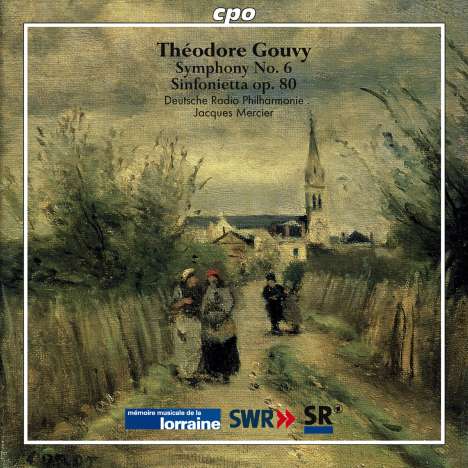Louis Theodore Gouvy: Symphonien Vol.2 auf CD
Symphonien Vol.2
Herkömmliche CD, die mit allen CD-Playern und Computerlaufwerken, aber auch mit den meisten SACD- oder Multiplayern abspielbar ist.
Lassen Sie sich über unseren eCourier benachrichtigen, falls das Produkt bestellt werden kann.
Symphonie Nr. 6 g-moll op. 87; Sinfonietta D-Dur op. 80
- Künstler:
- Deutsche Radio Philharmonie Saarbrücken Kaiserslautern, Jacques Mercier
- Label:
- CPO
- Aufnahmejahr ca.:
- 2007
- UPC/EAN:
- 0761203738021
- Erscheinungstermin:
- 15.11.2009
Théodore Gouvys Spätwerke
Diesen Monat setzen wir unsere Gouvy-Edition mit sinfonischen Spätwerken des deutsch-französischen Komponisten fort. Die Sinfonietta entstand 1885 in glücklichster Zeit: »Mir geht’s wie einem Rekonvaleszenten, der nach vielmonatlichem Fasten sich gar nicht mehr satt essen kann.« Die Komposition atmet eine lichte Atmosphäre, die an die gleichfalls klassizistisch getönte 2. Sinfonie von Brahms in derselben Tonart erinnert. Wie dieser komponiert Gouvy im ersten Satz der Sinfonietta ein freundliches Naturidyll. Mit seiner letzten Sinfonie, der Sechsten betritt Gouvy anderes Terrain: Feierliche Tuttiklänge, gedämpfte Paukenschläge und eine modal getönte Melodie beschwören in der Einleitung eine mittelalterliche Szenerie. Ein klingender Bilderbogen ist denn auch das ganze Werk.
Product Information
Théodore Gouvy’s Late Works
This month we continue our Gouvy edition with two symphonic works from this Franco-German composer’s late period. Gouvy composed his Sinfonietta – actually intended as a symphony but then retitled with the diminutive on the advice of Carl Reinecke and Salomon Jadassohn (to whom cpo soon shall turn) – in 1885 during a period of perfect happiness: »I feel like a convalescent who after many months of fasting can no longer eat his fill.« The composition exudes a bright atmosphere reminiscent of Brahms’s second symphony, it too classicistic in tone. Like Brahms, Gouvy produced a friendly natural idyll in the first movement. In his last symphony,
his sixth, with its second version dating to 1892, Gouvy ventured onto new terrain. In the introduction we encounter festive tutti passages, muted timpani beats, and a melody of modal color evoking the sort of medieval scenery of which painters of the nineteenth century were so fond: gloomy landscapes with castle ruins and battle scenes with knights. The work as a whole, crowned by a masterful concluding fugue, is a musical picture book.
Rezensionen
klassik-heute.com 01/10: »Ein musikalischer Glücksgriff, denn das Orchesterspiel ist untadelig und Jacques Merciers Darstellung sorgfältig, einfühlsam und von großer Überzeugungskraft.«Disk 1 von 1 (CD)
Sinfonie Nr. 6 g-moll op. 87
-
1 1. Poco adagio - Allegro
-
2 2. Scherzo: Allegro con brio
-
3 3. Andante con moto
-
4 4. Finale: Allegro risoluto
Sinfonietta D-Dur op. 80
-
5 1. Adagio - Allegro
-
6 2. Scherzo: Allegro
-
7 3. Tema con variazioni: Andante
-
8 4. Finale: Allegro
Mehr von Louis Theodore ...
-
Louis Theodore GouvyIphigenie en Tauride op.72 CDsVorheriger Preis EUR 14,99, reduziert um 0%Aktueller Preis: EUR 7,99
-
Louis Theodore GouvySämtliche Symphonien4 CDsAktueller Preis: EUR 19,99
-
Louis Theodore GouvySonaten für Klavier 4-händig op.36, op.49, op.51CDAktueller Preis: EUR 14,99
-
Louis Theodore GouvySymphonie Nr.2CDVorheriger Preis EUR 15,99, reduziert um 0%Aktueller Preis: EUR 7,99














